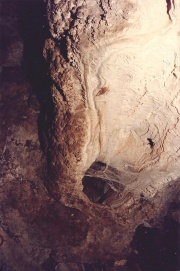Calcite (Inventory)/Rim
From LagWiki
| Line 16: | Line 16: | ||
*Palmer, Arthur N. (2007) ''Cave Geology'' CAVE BOOKS, Dayton, OH pp 331-333 ISBN-13: [[Special:Booksources/978-0-939748-66-2|978-0-939748-66-2]], ISBN-10: [[Special:Booksources/0-939748-66-5|0-939748-66-5]] | *Palmer, Arthur N. (2007) ''Cave Geology'' CAVE BOOKS, Dayton, OH pp 331-333 ISBN-13: [[Special:Booksources/978-0-939748-66-2|978-0-939748-66-2]], ISBN-10: [[Special:Booksources/0-939748-66-5|0-939748-66-5]] | ||
*Hill, Carol; Paolo Forti (1997) ''Cave Minerals of the World (Second Edition ed.)'' National Speleological Society pp 91-92 ISBN: [[Special:Booksources/1-879961-07-5|1-879961-07-5]] | *Hill, Carol; Paolo Forti (1997) ''Cave Minerals of the World (Second Edition ed.)'' National Speleological Society pp 91-92 ISBN: [[Special:Booksources/1-879961-07-5|1-879961-07-5]] | ||
| + | |||
| + | ==Bell Canopy, Calcite== | ||
| + | <gallery perrow=1 widths=300px heights=200px> | ||
| + | File:Calcite Rim Vent.jpg|Calcite Rim | ||
| + | </gallery> | ||
{{Cave inventory}} | {{Cave inventory}} | ||
Revision as of 03:28, 21 February 2018
The Rim field of the Calcite section should be used to record stations that exhibit rims of calcite. Other mineral rims have their own field in their respective sections.
Calcite rims (also sometimes known as vents) are wind formed features of calcite. They form usually around constrictions where consistent airflow is present. They are smooth on the inside but rough on the outside with features such as popcorn lining the outside surface. Rims form as a shell or projection extending on the upwind side of a constriction where moisture laden air consistently escapes. As such, they tend to require a pool or water source somewhere on the downwind side in order to provide the moist, warm air.
Rims can be any of a number of shapes from round tubes or eggs to more irregular shells or ears. They tend to conform somewhat to the shape of the constriction but may be biased in only one direction by the airflow. They can be found on the floor, walls or ceiling; anywhere air is or was escaping.
Rims can form from various mineral materials and several of them have fields on the inventory form. The appropriate field based on the mineral content of the rim feature should be used. Only calcite rims are recorded in this field.
See also
References
- Palmer, Arthur N. (2007) Cave Geology CAVE BOOKS, Dayton, OH pp 331-333 ISBN-13: 978-0-939748-66-2, ISBN-10: 0-939748-66-5
- Hill, Carol; Paolo Forti (1997) Cave Minerals of the World (Second Edition ed.) National Speleological Society pp 91-92 ISBN: 1-879961-07-5
Bell Canopy, Calcite
Calcite Rim Vent.jpg
Calcite Rim |

